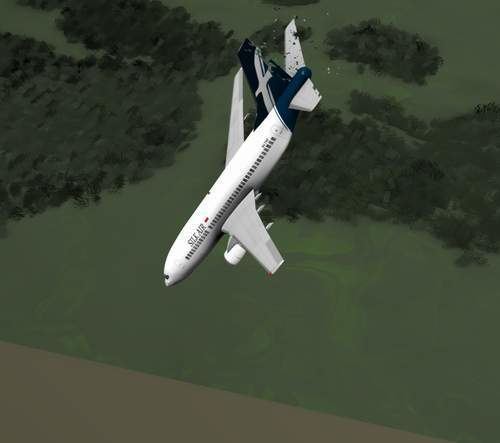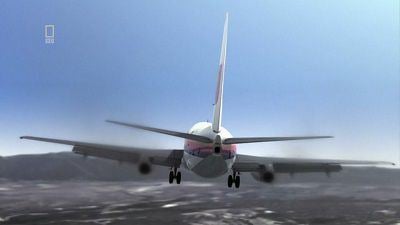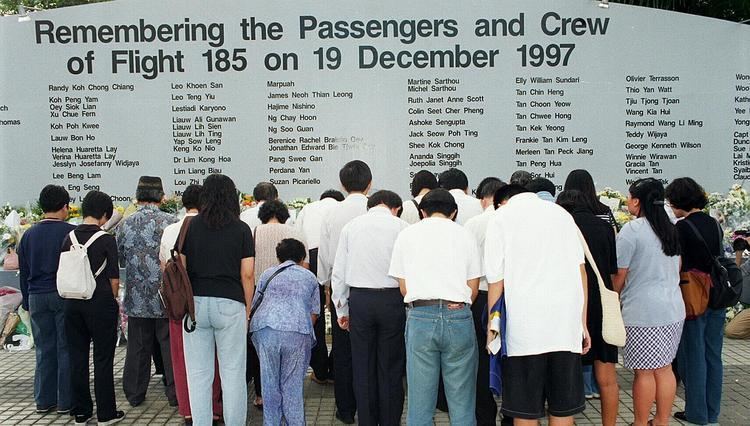Passengers 97 Date 19 December 1997 Fatalities 104 (all) Passenger count 97 | Survivors 0 Registration 9V-TRF Survivor 0 Crew count 7 | |
 | ||
Summary Deliberate crash by pilot (NTSB)Inconclusive evidence to determine cause (NTSC)rudder malfunction (Los Angeles Court) Similar EgyptAir Flight 990, TANS Perú Flight 204, Singapore Airlines Flight 006, Adam Air Flight 574, Eastwind Airlines Flight 517 | ||
Silkair flight 185 pilot suicide
SilkAir Flight 185 was a scheduled SilkAir passenger flight operated by a Boeing 737-300 from Jakarta, Indonesia, to Singapore, that crashed into the Musi River near Palembang in southern Sumatra, on 19 December 1997, killing all 97 passengers and seven crew on board.
Contents
- Silkair flight 185 pilot suicide
- Flight history
- Crash
- Passengers and crew
- Investigation and final report
- Potential motives
- PA announcement
- CVR and FDR deactivation
- Servo valve issue
- Lawsuits
- Dramatisation
- In popular culture
- References

The cause of the crash was independently investigated by two agencies in two countries: the United States National Transportation Safety Board (NTSB) and the Indonesian National Transportation Safety Committee (NTSC). The NTSB, which had jurisdiction based on Boeing's manufacture of the aircraft in the United States, investigated the crash under lead investigator Greg Feith. Its investigation concluded that the crash was the result of deliberate flight control inputs, most likely by the captain. The Indonesian NTSC, led by Engineering Professor Oetarjo Diran, was unable to determine a cause of the crash.

Another potential factor that led to the crash of the 737 aircraft was the power control unit (PCU) that controlled the aircraft's rudder. The cause of some 737 crashes such as USAir Flight 427 had been attributed to the 737's rudder issues. Although the NTSB and PCU manufacturer Parker Hannifin had already determined that the PCU was properly working, and thus not the cause of the crash, a private investigation into the crash for a civil lawsuit tried by jury in a California state court in Los Angeles, which was not allowed to hear or consider the NTSB's and Parker Hannifin's conclusions, decided that the crash was caused by a defective servo valve inside the PCU, based on forensic findings from an electron microscope which determined that minute defects within the PCU had caused the rudder hard-over and a subsequent uncontrollable flight and crash. The manufacturer of the aircraft's rudder controls and the families later reached an out-of-court settlement.

Flight history

The aircraft operating flight 185 was a Boeing 737-300 with manufacturer serial number 28556, registered as 9V-TRF and was powered by two CFM56-3B2 engines. Having completed its maiden flight in January 1997, the aircraft was delivered to SilkAir in February 1997, 10 months before the crash. At the time of the accident, it was the newest aircraft in SilkAir's fleet and had accumulated 2,238 flight hours in 1,306 cycles.

Carrying 97 passengers and a crew of seven, the Boeing 737 departed Jakarta's Soekarno-Hatta International Airport's runway 25R at 15:37 local time (08:37 UTC) for a planned 80-minute flight to Singapore Changi Airport, with captain Tsu Way Ming (朱卫民), 41, of Singapore, a former A-4 Skyhawk pilot, at the controls along with first officer Duncan Ward, 23, of New Zealand. Generally fair weather was expected for the route, except for some thunderstorms near Singkep Island, 120 km (75 mi) south of Singapore.

The aircraft was cleared to climb to flight level 350 (FL350), about 35,000 ft (11,000 m), and to head directly to Palembang. At 15:47:06, while climbing through 24,500 ft (7,468 m), the crew requested clearance to proceed directly to waypoint PARDI (0°34′S 104°13′E). At 15:53, the crew reported reaching the cruise altitude of FL350 and was cleared to proceed directly to PARDI, and to report abeam Palembang. At 16:05, the cockpit voice recorder (CVR) ceased recording. The TV series Mayday argues Captain Tsu may have taken the opportunity of leaving the cockpit for tripping the CVR circuit breaker in order to turn off the CVR. At 16:10, the air traffic controller informed the flight that it was abeam Palembang and instructed the aircraft to maintain FL350 and to contact Singapore Control upon reaching PARDI. First Officer Ward acknowledged this call. At 16:11, nearly six minutes after the CVR ceased recording, the flight data recorder (FDR) also stopped recording. Mayday shows that Ming is thought of as having likely came up with an excuse to get Duncan out of the cockpit. Once that was done, the pilot then proceeded to lock his own co-pilot out of the flight deck before disabling the data recorder; Ming is presumed to have done this in order to ensure that there would be no record of what he was going to do next.
Crash
Flight 185 remained level at FL350 until it started a rapid and nearly vertical dive around 16:12. While descending through 12,000 ft (3,700 m), parts of the aircraft, including a great extent of the tail section, started to separate from the aircraft's fuselage due to high forces arising from the nearly supersonic dive. Seconds later, the aircraft impacted the Musi River, near Palembang, Sumatra, killing all 104 people on board. The time it took the aircraft to dive from cruise altitude to the river was less than one minute. The plane was travelling faster than the speed of sound for a few seconds before impact. Parts of the wreckage were embedded 15 feet into the riverbed.
The aircraft broke into pieces before impact, with the debris spread over several kilometres, though most of the wreckage was concentrated in a single 60-metre (200 ft) by 80-metre (260 ft) area at the river bottom. No complete body, body part or limb was found, as the entire aircraft and passengers disintegrated upon impact. Only six positive identifications were later obtained from the few recovered human remains.
Passengers and crew
Silk Air issued a press release on 19 December 1997 with a passenger count by nationality, and another the following day with crew details and a complete passenger manifest.
Among those killed in the crash was Singaporean model and author Bonny Hicks.
Investigation and final report
The accident was investigated by the Indonesian NTSC, which was assisted by expert groups from the US, Singapore, and Australia, and the American NTSB.
Around 73% of the wreckage (by weight) was recovered, partially reconstructed, and examined. Both of the aircraft recorders, the cockpit voice recorder (CVR) and the FDR (flight data recorder) were retrieved from the river and their data were extracted and analysed.
At 16:00, the CVR showed that Captain Tsu left the cockpit; five seconds later, the CVR stopped recording. Tests indicated that a click would be heard on the CVR recording if the CVR circuit breaker had tripped normally, but not if it had been pulled out manually. As there was no click, it is likely that Captain Tsu pulled out the CVR circuit breaker before leaving the cockpit. The NTSC and NTSB investigators thought that if Captain Tsu was responsible for the crash, he must have made up some excuse to get the First Officer to leave the flightdeck prior to disabling the FDR (which would have immediately triggered a Master Caution on both pilots' control panels), so his actions would not be noticed. Several minutes later, as recorded by Indonesian ground radar, the aircraft entered a rapid descent, disintegrated, and crashed into the Musi River.
On 14 December 2000, after three years of investigation, the Indonesian NTSC issued its final report, in which it stated that the evidence was inconclusive and that the cause of the accident could not be determined:
The US NTSB, which also participated in the investigation, concluded that the evidence was consistent with a deliberate manipulation of the flight controls, most likely by the captain.
In a letter to the NTSC dated 11 December 2000, the NTSB wrote:
The examination of all of the factual evidence is consistent with the conclusions that: 1) no airplane-related mechanical malfunctions or failures caused or contributed to the accident, and 2) the accident can be explained by intentional pilot action. Specifically, a) the accident airplane’s flight profile is consistent with sustained manual nose-down flight control inputs; b) the evidence suggests that the cockpit voice recorder (CVR) was intentionally disconnected; c) recovery of the airplane was possible but not attempted; and d) it is more likely that the nose-down flight control inputs were made by the captain than by the first officer.
Geoffrey Thomas of The Sydney Morning Herald said that "a secret report confirmed that the Indonesian authorities would not issue a public verdict because they feared it would make their own people too frightened to fly." Santoso Sayogo, an NTSC investigator who worked on the SilkAir 185 case, said that the NTSB opinion was shared by some Indonesian investigators, who were over-ruled by their boss.
Potential motives
In the aftermath of the crash, several potential motives for the captain's alleged suicide/homicide were suggested, including recent financial losses of $1.2 million (his share-trading showed trading of more than one million shares and his securities-trading privileges had been suspended 10 days before the accident due to nonpayment), his obtaining a $600,000 life insurance policy the previous week which was to have gone into effect on the day of the accident (though it later emerged that this was a routine policy taken out as part of a mortgage requirement), his receipt of several recent disciplinary actions on the part of the airline (including one that related to improper manipulation of the CVR circuit breaker), and the loss of four squadron mates during his military flight training, 18 years earlier on the exact date of the crash. He had also had several conflicts with Ward and other copilots who had questioned his command suitability. Investigations later revealed that his total assets were greater than his liabilities, although his liquid assets could not cover his immediate debts; his monthly income was less than his family's monthly expenditure; and he had some outstanding credit card debts.
An official investigation by the Singapore Police Force into evidence of criminal offence leading to the crash found "no evidence that the pilot, copilot or any crew member had suicidal tendencies or a motive to deliberately cause the crash of [the aircraft]."
Tsu was formerly a Republic of Singapore Air Force pilot and had over 20 years of flying experience in the older T/A-4S Skyhawks, as well as the newer T/A-4SU Super Skyhawks. His last appointment was instructor pilot of a Skyhawk squadron.
PA announcement
Captain Tsu made what appeared to be a routine public address announcement about the flight at 15:44:37, about 7 min after takeoff, which was recorded by the CVR and transcribed by the NTSC: Tsu's announcement ended at 15:46. At 16:05, 19 minutes later, the CVR stopped recording. Six minutes later, at 16:11, the FDR stopped recording, and at 16:12 the aircraft plunged into its fatal dive.
CVR and FDR deactivation
The cockpit voice recorder and flight data recorder stopped recording minutes before the abrupt descent, but not at the same time. The CVR stopped functioning approximately 6 minutes before the dive as the captain was leaving the cockpit for a short break. The FDR recorder was deactivated 5 minutes later approximately one minute before the dive. Overload and short circuit tests show that a distinctive 400-Hz tone is recorded by the CVR when the CVR circuit breaker trips. The investigators could not find this sound on Flight 185's CVR, which made them conclude that the CVR circuit breaker was manually pulled out. The radio continued to work after the failure of the CVR, which indicates that power failure was not the cause. Subsequent investigations, including a National Geographic Channel documentary, revealed that this FDR had previously failed, for periods lasting between ten seconds and ten minutes. Testing of the unit by NTSC found no evidence that a malfunction or failure caused either recorder to stop recording data.
Servo valve issue
Starting in 1991, several accidents and incidents involving the Boeing 737 were the result of uncommanded movement of their rudders. On 3 March 1991, United Airlines Flight 585, a 737-200, crashed in Colorado Springs, Colorado, killing 25 people. On 8 September 1994, USAir Flight 427, a 737-300, crashed near Pittsburgh, Pennsylvania, killing 132 people. There were four more incidents where a 737 rudder power control unit (PCU) malfunction was suspected.
The Seattle Times devoted a series of 37 articles to Boeing 737 loss of control malfunctions. The accident occurred in the middle of a controversy over the NTSB's role in accidents caused by the rudder control unit.
During the investigation of Flight 427, the NTSB discovered that the PCU's dual servo valve could jam, as well, and deflect the rudder in the opposite direction of the pilots' input, due to thermal shock, caused when cold PCUs are injected with hot hydraulic fluid. As a result of this finding, the Federal Aviation Administration (FAA) ordered the servo valves to be replaced and new training protocol for pilots to handle unexpected movement of flight controls to be developed. The FAA ordered an upgrade of all Boeing 737 rudder control systems by 12 November 2002.
According to the series Mayday, the rudder issue had been corrected before construction started on the accident aircraft. Nevertheless, the theory of a rudder malfunction was investigated with the possibility of corrosion of and/or debris getting stuck in the power control unit, and was disproved.
Lawsuits
SilkAir paid US$10,000 compensation to each victim's family, the maximum under the Warsaw Convention. Boeing also paid an undisclosed amount of compensation. In 2001, six families who had sued SilkAir for damages based on the allegation that the crash was caused by the pilot were turned down by a Singapore High Court judge, who ruled, "the onus of proving that flight MI185 was intentionally crashed has not been discharged."
Despite the fact that the NTSB and Parker Hannifin had already ruled out the possibility of mechanical failure as a cause to the crash of Flight 185 due to a defective PCU servo valve-unit (manufactured by Parker Hannifin), an independent and private investigation refocused on and further examined the recovered PCU device whose malfunctioning has been pointed out in other sudden Boeing 737 crashes. The manufacturer's records relating to this particular unit revealed that it had failed some routine tests, but they claimed to have corrected these problems. A metals expert, with the use of images from a scanning electron microscope, concluded that the servo valve had 'chip-outs' and numerous burrs "that could easily have interfered with the smooth operation of the valve." After this investigation was complete, in 2004, a Los Angeles Superior Court jury in the United States, which was not allowed to hear or consider the NTSB's conclusions about the accident, found that the crash was caused by a defective servo valve in the plane's rudder. The hydraulic PCU device manufacturer, Parker Hannifin, was ordered to pay the three families of victims involved in that case US$43.6 million. After threatening to appeal the verdict, Parker Hannifin later compensated all families involved (although it did not accept liability).
Dramatisation
The Discovery Channel Canada / National Geographic TV series Mayday (also called Air Crash Investigation or Air Disasters) dramatised the accident in a 2012 episode titled Pushed to the Limit (broadcast in some countries as Pilot Under Pressure).
In popular culture
Singaporean singer JJ Lin (林俊杰)'s 2013 song Practice Love (修煉愛情) from the album Stories Untold (因你而在) is based on this accident, as a close friend of the artist was killed on the flight.
